Saint Paul of the Cross, Priest
Founder of the Congregation of the Passion of Jesus Christ and of the Passionist Nuns
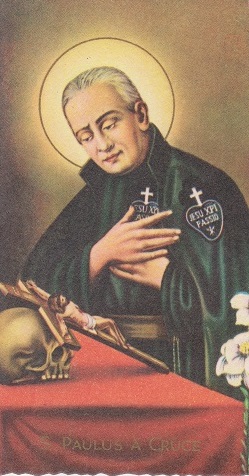
Paul Daneo was born in 1694 at Ovada, Piedmont. During his youth, he helped his father in business. Called by God to follow the example of Jesus Crucified, he received the religious habit in 1720 and committed himself totally to asceticism and the apostolate. While temporarily engaged in the care of the sick at Rome, he was ordained to the priesthood by Pope Benedict XIII. He then withdrew into solitude on Monte Argentario together with his brother, the Venerable Father John Baptist of Saint Michael the Archangel and, under God's inspiration, founded the Congregation of the Passion. The principal purpose of the Congregation is to meditate on and proclaim the passion and death of the Lord. For the same purpose, he also founded the Passionist Nuns as a contemplative community. Tireless preacher of the word of the Cross, outstanding superior of the Congregation, eminent model of penance and contemplation, and enlightened director of souls, Paul of the Cross is considered the greatest mystic of the eighteenth century. He died in Rome on October 18, 1775.
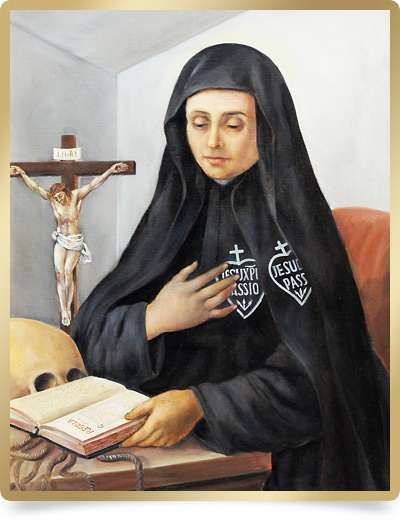
Venerable Mother Mary Crucified, Co-foundress
In the "Life of St. Paul of the Cross" by Vincent Strambi, evidence can be found of Paul's intentions from the beginning of the Congregation of the Passion to found an institute in which women, consecrated to the service of God, could devote themselves to prayer and meditation on the Passion of Jesus. However, it was not until the end of Paul's life that he wrote the rules of this institution, which were approved by the brief of Clement XIV in 1770.
Working with Paul on the foundation of the Passionist nuns was Mother Mary Crucified, whose secular name was Faustina Gertrude Constantini. She was born at Corneto, 18 August 1713. In youth, she placed herself under the direction of St. Paul of the Cross, and became a Benedictine nun in her native city, awaiting the establishment of a Passionist convent. Through the generosity of her relatives, Dominic Costantini, his brother Nicolas, and his wife Lucia, a site was obtained for the first convent of the new institute in Corneto, and a suitable house and chapel were built.
On the Feast of the Cross, 1771, Mother Mary Crucified, with the permission of Clement XIV and with ten postulants, was clothed in the habit of the Passion and entered the first convent of Passionist nuns, solemnly opened by the vicar capitular of the diocese. Paul, detained by illness, was represented by the first consultor general of the order, Father John Mary. Mother Mary Crucified became the first mother superior of her order and remained so until her death in 1787.
The spirit of the institute and its distinctive character is devotion to the Passion of Christ, to which the sisters bind themselves by vows. Sisters live austere lives, and postulants seeking admission to the strictly enclosed convents must have a dowry. The sisters chant or recite the Divine Office in common and spend the greater part of the day in prayer and other duties of piety. They attend to the domestic work of the convent, and occupy themselves in their cells with needlework, making vestments etc.
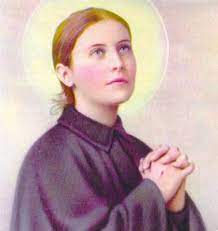
Saint Gemma Galgani
Saint Gemma was born in 1878 near Lucca, Italy. From her childhood she dedicated herself to meditation on the Passion of Jesus Christ, leading an innocent life and longing ardently for heaven. She was orphaned and then charitably welcomed into the home of a deeply Christian family. Consecrating herself to God by a vow of virginity, she joyfully applied herself to run the way of perfection. She had a singular devotion toward the Eucharist and toward Jesus Crucified. Graced with special supernatural charisms, she offered herself to God for the conversion of sinners. Although her ardent desire to enter the Passionist Nuns was never realized because of various difficulties, she distinguished herself as an extraordinary exemplar of holiness in the midst of the world. She died at Lucca on Holy Saturday, April 11, 1903.
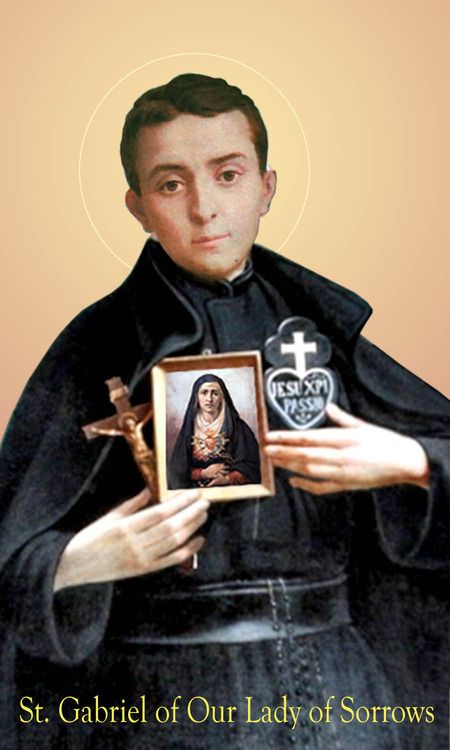
Saint Gabriel of the Sorrowful Mother
Francis Possenti was born at Assisi in Umbria on March 1, 1838. While very young, he attended school at Spoleto and seemed to be strongly attracted to the world. However, under the call of God's grace, he entered the Congregation of the Passion of Jesus Christ where he lived so crucified to the world and so intimately united to God that he became a model of all the virtues, especially humility and obedience. Moreover, he had a very great devotion to the Sorrowful Virgin who was, as it were, the whole reason for his holiness. He died at Isola of Gran Sasso in the Abruzzi on February 27, 1862. Near his tomb, there arose a large sanctuary, a place of faith pilgrimages and a center of religious influence. In 1926, Saint Gabriel was declared joint patron of the Catholic Youth of Italy and in 1959, principal patron of the Abruzzi.
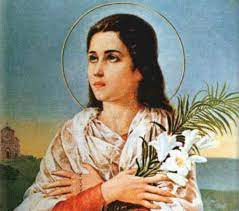
Saint Maria Goretti
Maria Goretti, born in 1890, is honored as one of the first Passionist martyrs. She was the daughter of poor share-croppers who lived in the Italian countryside. She lost her father to malaria as a child, and it is this loss that many feel contributed to her sense of strength and maturity.
On July 5, 1902, at the age of 12, Maria made her First Communion at the nearby Passionist church. Shortly after, alone in her home except for her little sister, Maria was attacked by Alessandro Serenelli. When she would not submit to his advances, he stabbed Maria 14 times. She held him off courageously, but was mortally wounded.
When Serenelli's father and Maria's mother came to check on the little girl, they found the bleeding Maria and took her to the nearest hospital in Nettuno. She underwent surgery without anesthesia, but her injuries were too grave. The following day, twenty hours after the attack, having expressed forgiveness for her murderer and stating that she wanted to have him in heaven with her, Maria died of her injuries.
Alessandro Serenelli was captured shortly after Maria's death and spent 30 years in prison. He remained unrepentant and uncommunicative for several years, although in time he corresponded with a Bishop who had visited him in jail. It was to him that Serenelli reported a dream, "in which Maria Goretti gave him lilies, which burned immediately in his hands".
After his release, Serenelli went to Maria's still-living mother, Assunta, and begged her forgiveness. She forgave him, saying that if Maria had forgiven him on her deathbed then she couldn't do less. Serenelli eventually became a Capuchin lay brother, and worked in a convent as its receptionist and gardener until he died in 1970.
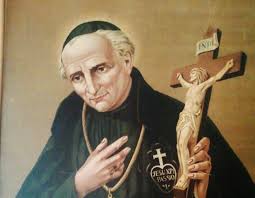
Saint Vincent Mary Strambi
Saint Vincent Strambi was born at Civitavecchia in 1745. A short time after his ordination to the priesthood, he entered the recently founded Passionist Congregation. Travelling throughout most of Italy, he endeavored to promote the Christian life among the people by his preaching on the Passion. He wrote hagiographical and devotional books, the most significant of which was that on the Precious Blood. Being an outstanding Spiritual Director, he directed, among others, Saint Gaspar of Bufalo and Blessed Anna Maria Taigi. Appointed Bishop of Macerata and Tolentino, he showed himself to be a true Shepherd of his flock and promoted the reform of the clergy and the people with apostolic zeal. In political upheavals of the time, he was a fearless advocate of the freedom of the Church and chose exile in preference to an unlawful oath of loyalty to Napoleon. When he returned to his see after exile, he once again manifested his deep pastoral concern and extraordinary charity for the poor. Called by Pope Leo XII to become his personal advisor, he died in the Quirinal on January 1, 1824, after having offered himself to God in place of the pope, who was seriously ill.
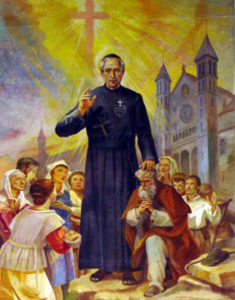
Saint Charles of Mount Argus
St. Charles Houben, more popularly known as Father Charles of Mount Argus was born in Holland. He was given the name Johannes Andreas by his parents. He felt a calling to religious life and, in 1845, he was accepted by the Passionists who had very recently arrived in Belgium under the leadership of Dominic Barberi.
Father Charles, as he became known, was sent to support the Passionists in Ireland where they had recently arrived at the monastery of Mount Argus in Dublin. He would serve most of his life here except for a few years in England. Charles never managed to speak English very well. His Dutch accent was thick and he was often hard to understand. But he quickly gained a reputation for his amazing compassion for the sick and those in need of guidance. His reputation for healing and miracles was so great at the time that a reference is made to him in the famous novel Ulysses by James Joyce.
His ability to stand with people and to read what was in their hearts made him the apostle of the poor in a city filled with people who were poor. His love and amazing kindness shone through and touched the lives of thousands of people. "Our Father Charles" became the talking point of Dublin. He was named Saint Charles. His feast is January 5.
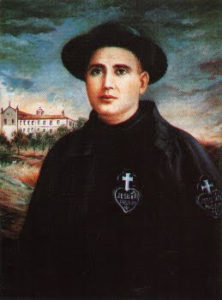
Saint Inocencio Canoura Arnau, Priest and Martyr (1887-1934)
Blessed Inocencio of Mary Immaculate (Emanuele Canoura Arnau) was born on March 10, 1887, in Santa Lucia del Valle de Oro, Spain. Professed a Passionist on July 27, 1905 and ordained a priest on September 20, 1913. He was most zealous in exercising this ministry in various communities of his religious province (Precious Blood). During the so-called "Revolution of Asturias of 1934", while he was celebrating mass in the Institute of the Brothers of the Christian Schools in Turón, he, together with eight LaSalle Brothers, was taken prisoner by those who were filled with hatred for religion. All were executed on October 9, 1934. Inocencio, together with those martyred with him, was canonized by Pope John Paul II.
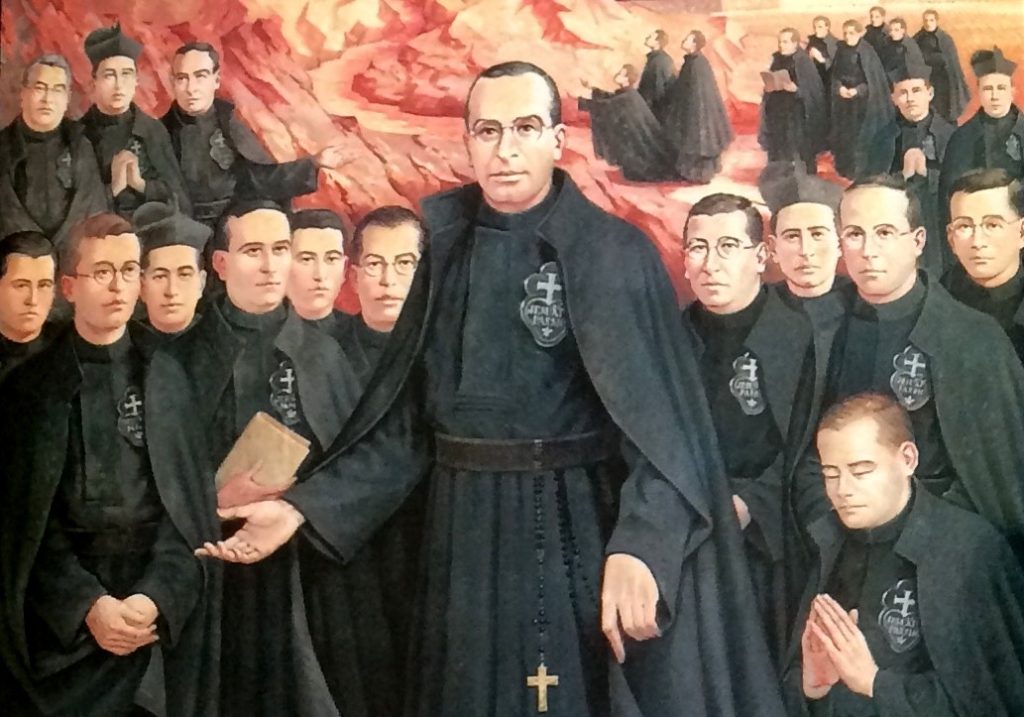
Blessed Niceforo
Blessed Nicéforo de Jesús y María (Vicente Díez Tejerina) was born in 1893 and Blessed Juan Pedro de San Antonio (José María Bengoa Aranguren) in 1890. Both were born in Spain. Aspiring to do something meaningful in their life, they responded to God's call generously by embracing religious life in the Passionist Congregation. They volunteered as students to go as missionaries to the American Continent. They studied at Toluca, Mexico, but because of the persecution of the Church during the presidency of Plutarco Calles, they were imprisoned and they exiled to the United States. They completed their studies for the priesthood in Chicago and were ordained in the cathedral by Archbishop Mundelein in 1916. They preached many popular missions among the Latinos in United Sates, Mexico and Cuba.
Vicente Díez Tejerina Juan Pedro had to return to Spain in 1926 and Necéfero in 1932 to take up responsibilities of leadership of the Passionist Congregation in their country. As the civil war was breaking out in Spain in 1936, both died heroically as martyrs defending the Catholic faith along with other 24 Passionists, by a group of anti ecclesial anarchists. Before they died, Nicéfero who was the Provincial Superior, stationed in Daimiel, exhorted his community, mostly students, to be brave like Jesus in the Garden of Gethsemane, gave them general absolution and Communion to strengthen them spiritually.
As he was dying, Nicéfero with a bullet in his body, smiled at his persecutor offering him forgiveness, but the other, enraged, put an end to Nicefero's life with another bullet.
Pedro Bengoa, was martyred a few days later in Ciudad Real. His last words were "Long live Christ the King"
The martyrs were beatified by Pope John Paul II. As Christ in the Garden of Gethsemane, their example strengthens us to be courageous in taking important challenging decisions at difficult times of our life and/or of the historical period we live in.
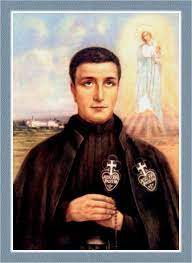
Blessed Grimoaldo of the Purification, (Ferdinando Santamaria), (1883-1902)
Born to Peter Paul and Cecilia Santamaria on May 4 1883 and baptized Ferdinando the following day. His parents ran a small rope-making business and they were a devoutly Christian couple.
In an extra-ordinary occasion, Grimoaldo received the sacrament of Confirmation at the unusually young age of five months. An altar server from a young age, Ferdinando was also a member of the church choir and the Soldality of the Immaculate Conception. A neighbor testified that on one occasion he saw Ferdinando lifted from the floor while in prayer.
In 1850, members of the Passionist Congregation took possession of a monastery in the locality, and Ferdinando soon became familiar with them, copying their lives of penance. His father encouraged him to continue working in the family business, but Ferdinando had become convinced that he wanted to join the Passionists. He was not yet 16 and his age prevented him from entering the monastery. While waiting until he was the required age, Ferdinando took up lessons in Latin. He entered the novitiate of the Passionists on March 5, 1899 at the monastery of St. Mary of Pugliano, taking the religious name Grimoaldo of the Purification.
The Rule of the Passionists was severe and designed to test the novices with penances such as sleeping on straw, poverty in clothing and the wearing of a rough black tunic. Grimoaldo was especially keen to model his life on Saint Gabriel of Our Lady of Sorrows, a Passionist student.
He made his vows as a Passionist religious on March 6, 1900. Grimoaldo began his studies for the priesthood at Ceccano where he found difficulty in adopting a scholastic discipline, a difficulty soon overcome. Among the Passionists, he was known for his great holiness and charity. In November 1902 he was diagnosed with acute meningitis and after many trials and temptations he died on November 18, 1902. On his deathbed he prophesized the date of his own death and that of a Cardinal;
"His Divine Majesty is here, he has come for me today, and I, together with him, must go to Rome for Cardinal Aloisi-Masella. I must be his companion in death."
The Cardinal died four days later.
He was beatified by Pope John Paul II in 1995.
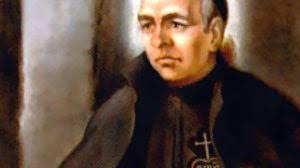
Blessed Dominic Barberi
Dominic was born to a poor family of Italian farmers in 1792. Orphaned at the tender age of eight, an uncle and aunt raised him in the town of Merlano. Young Dominic was not sent to school, but instead was taught to shepherd sheep. But the child always found time to pray as he tended the sheep, and he also diligently taught himself to read and write.
When Napoleon closed all the religious houses in Italy, Dominic became acquainted with several Passionists living in exile near his town. During this time, Dominic experienced a divine message to join the Passionists and one day go to England.
Dominic had promised God that if he were not drafted, he would become a Passionist. Unfortunately, he soon forgot his promise. Dominic's uncle and aunt had also planned a marriage for him. But just before the arranged marriage was to take place, he slipped away and instead entered the nearby Passionist monastery at Vetralla. Dominic studied eagerly, for he had a brilliant mind. He was ordained in Rome on March 1, 1821. For the next nineteen years he shared the life and ministries of the Passionists in Italy, but his heart was in England.
Mission in England
In 1833, Dominic became a delegate to the General Chapter. In this capacity, he was able to plant the seed to send missionaries to England. By the time of the 1839 General Chapter, changes in the Congregation were afoot. The new General Superior was the charismatic Father Anthony Testa. By April of 1840, Father Testa decided that Dominic should go to England, though he worried for Dominic's failing health. He sent him with three companions to Belgium to make a foundation in that country with the hope that from Belgium the mission to England could be realized. Dominic established the first Passionist monastery outside of Italy in 1840, at Ere in Belgium.
Finally, the time came to establish the first Passionist residence in England. Father Dominic and a companion went to England and obtained a house at Aston Hall in Staffordshire. One of his first ministries was the celebration of the 1842 Holy Week services.
Dominic felt blessed to receive the famous Anglican John Henry Newman into the Catholic Church. "What a spectacle it was for me to see Newman at my feet! All that I have suffered since I left Italy has been well compensated by this event. I hope the effects of such a conversion may be great." On the following Sunday, Newman and four companions went to the Catholic Chapel of St. Clement's at Oxford for Mass. All England soon knew that they were now Roman Catholics.
English vocations were few, but Dominic was deeply consoled by the arrival of Father George Spencer who received the habit on January 5, 1847. Spencer was a convert of some years and already ordained when Dominic came to England in 1841. Now as a fellow Passionist, he proved a great comfort to Dominic and the Passionists.
In August, 1849, Dominic was returning to Aston Hall from London. About five miles from Reading, Dominic got desperately sick. He was taken off the train to be attended by a doctor, but there was not a room for him at the small station of Pangbourne. Father Louis put him back on the train for Reading. He died there from a heart attack at 3:00 p.m., August 27, 1849.
In the tradition of Blessed Dominic (he was beatified by Pope Paul VI in 1963), Passionists would be aware that ecumenism is an essential part of their heritage. At the time of the Second Vatican Council, Passionists accepted with joy the call to engage in ecumenical ministries. The "renewal" of the Congregation in the spirit of Vatican II would challenge the modern Passionist to this ecumenical mission.
(Text adapted from The Story of the Passionists by Roger Mercurio, C.P. All rights reserved by the Passionist Community,)
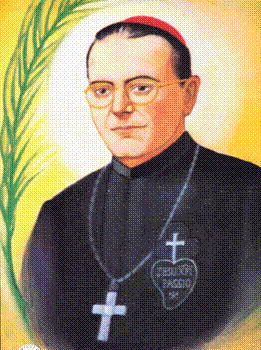
Blessed Eugene Bossilkov, C.P.
Bishop & Martyr (1900-1952)
The Passionist Bishop and Martyr, Eugene Bossilkov, was born November 16, 1900 in Belene (Bulgaria), a village in the Danube Valley. His family was farmers and Catholics of the Latin Rite. They gave him the name Vincent at baptism.
In 1914 he began his studies with the Passionists, who had been missionaries in northern Bulgaria since the late 1700s. He studied in Passionist seminaries in Belgium and Holland, and in 1920 became a professed member of that community. He took the name Eugene, and to the vows taken by religious, he joined the additional vow taken by the Passionists: to keep in constant memory the Passion of Jesus.
In 1924, he returned to Bulgaria to continue his theological studies and was ordained by Passionist Bishop Damian Theelen in 1926.
In 1927, he was sent to Rome to pursue doctoral studies at the Pontifical Oriental Institute, where he wrote his thesis: On the Union of Bulgarians with the Roman Church in the Early 13th Century. In 1933, he returned to his diocese, to become secretary to the bishop and pastor of the cathedral. Since he preferred ministry with the people, however, he was assigned as pastor of the town of Bardaski-Gheran in the Danube valley, where he brought new life into the parish through his liturgical and catechetical efforts. He was especially concerned for the young whom he tried to inspire through a variety of religious, social and sports programs.
His reputation grew as a gifted linguist and as a cultured scholar and was generally admired. In 1938, on the 250th anniversary of the Catholic insurrection against the Turks, he was chosen as the official speaker.
But times changed. In 1940, Bulgaria joined the Axis in the Second World War. Four years later the Soviet Union invaded Bulgaria after the retreat of German troops and subjugated the country militarily, politically and ideologically. After the death of Bishop Theelen in 1946, Father Bossilkov was ordained Bishop of Nicopolis in 1947. Churches faced a new round of difficulties from government laws drafted to destroy religion.
In 1948, Bishop Bossilkov received government permission to go to Rome for his "Ad limina" visit, where he was received by Pope Pius XII. He took the occasion to visit friends and companions in Holland. Then he returned to his diocese where he began a series of missions to prepare his people for the religious persecution they were certain to face. In 1949, the Apostolic Delegate to Bulgaria was expelled, and new steps were taken by the government to crush the Catholic Church and create a national church in its place. Laws were passed expelling all foreign missionaries, confiscating Church property and institutions, suppressing religious congregations and dispersing their members.
In 1950-51 the noose of persecution tightened until in 1952 mass arrests of church leaders began. Bishop Bossilkov was seized July 16, 1952, while on vacation at a house outside Sophia. Arrested at the same time as Bossilkov were 40 other priests, some religious and lay people. On August 8th, Father Fortunato Bakalski, superior of the Capuchin community of Sophia, was arrested.
Confined to prison in Sophia, Bishop Bossilkov was physically and mentally tortured to make a confession. On September 20, the party newspapers published accusations against him on their first page. A dummy trial was conducted from September 29th to October 3rd. A witness at the first courtroom session, K. Drenikov, described the scene.
On a large table there were "proofs" of guilt. There were two pistols, which were taken from the
Catholic college in Sophia, where they were conserved as museum pieces. Also there was an old radio transmitter that, according to the judges, was used to transmit coded messages to foreign sources. Bosilkov was presented as "chief" of a subversive Catholic spy organization.
The trial ended with a guilty verdict.
Condemned with Bishop Bossilkov on similar charges were the Assumptionist priests, Kamen Vicev Jonkov, Pavel Dgidgiov, Josafat Sciskov, and the Capuchin priest, Fortunato Bakalski. The official sentence against Bishop Bossilkov read:
By virtue of articles 70 and 83 of the penal code, the court condemns the accused, Eugene Bossilkov, to be sentenced to death by firing squad, and all his goods confiscated… Dr.Eugene Bossilkov, Catholic bishop; completed his religious studies in Italy and was trained by the Vatican for counter-revolutionary activities and espionage. He is one of the directors of a clandestine Catholic organization. He was in touch with diplomats from the imperialist countries and gave them information of a confidential nature. The accused convoked a diocesan council in which it was decided to combat communism through religious conferences, held in Bulgaria, activities called ' a mission.' No appeal of his sentence is possible. The High Court, Sophia, Bulgaria, October 3, 1952
At the last, he said to his niece and to his friends: "Don't worry about me; I have been given God's grace, and I am going to remain faithful to Christ and to the Church.
He was executed in the prison at Sophia on the night of November 11, 1952 at 11:30 p.m. His body was thrown into a common grave for criminals; the precise location of his burial place and his body is unknown.
Taken from:
https://www.passionistnuns.org/Saints/BlEugeneBossilkov/index.htm
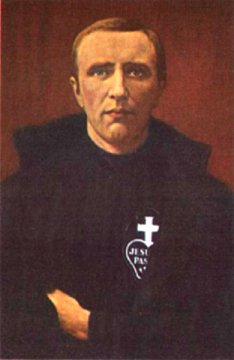
Blessed Isidore of St. Joseph (De Loor), Religious Brother (1881-1916)
Isidore De Loor, known in the Passionist Congregation as Isidore of St. Joseph, was born April 13, 1881, in the small town of Vrasene, located in the diocese of Gent-Gand, in Eastern Flanders. He was from a family of farmers, and he grew up loving his work in the fields. At the age of 26, he felt the call of God to the religious life, and entered the novitiate of the Passionist Congregation in Ere, where he was received as a lay-brother. He professed his religious vows on September 13, 1908. Thereafter he humbly served several communities of the Congregation; to his community service was joined an especially intense life of prayer and penance, in keeping with the spirit of the Congregation. His right eye had to be removed in 1911 because of a tumor. Among the religious of the Congregation, and among the laity, he was admired for his charity and simplicity, his dedication to work and his spirit of recollection. Having suffered through several months of intense pain, he succumbed to cancer and pleurisy on October 6, 1916. He was only 35 years of age, and had lived as a religious for only nine years. He was called by many "the good Brother," and "the Brother of the will of God." The Supreme Pontiff, Pope John Paul II, declared him blessed on September 30, 1984.
Printed by Passionist Generalate, Rome 1992 with update of Canonization.
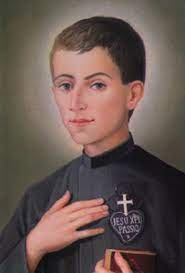
Blessed Pius of Saint Aloysius,
(Luigi Campidelli), religious (1868-1874)
Luigi Campidelli was born to a family of impoverished farmers at Poggio Berni (Forli) on April 29, 1868. He was the fourth child born to Giuseppe and Filomena.
Giuseppe caught typhoid in 1874 and died, leaving the family destitute. An uncle came to their aid, but his lax morality was a trial for the devout family.
In his schooling Luigi was an admirable, and in his teens he became more active in the life of his parish. He was known throughout the neighborhood as a good child and soon he felt a call to the priesthood. He was especially loyal to the Pope at a time when his native province of Romagna was torn between Catholics and atheistic secularists.
He encountered Passionist priests at the age of 12 and immediately wanted to join them. From this time on he was a frequent visitor to the Passionist house at Casale. He entered the Passionists at 14 years of age.
The young Luigi was drawn to the Mother of God, to the mystery of the Eucharist and to Jesus Crucified. His way of holiness was fidelity to ordinary things with an extraordinary love. He entered the novitiate and on May 27, 1883. He was clothed in the Passionist habit and received the religious name Pius of Saint Aloysius.
The novitiate was temporarily transferred to Viterbo, the city in which fellow Passionist Blessed Dominic Barberi was born. Pius continued his theological and philosophical studies and on April 30, 1884 took his vows.
He received Minor Orders but was struck down with tuberculosis before he could be ordained priest. He died at 21 years of age on November 2, 1889, offering his life for his troubled home region of Romagna.
Pius of Saint Aloysius was solemnly beatified by Pope John Paul II on November 17, 1985.
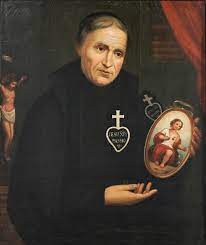
Blessed Lorenzo Maria Salvi, 1782-1856
Blessed Lorenzo Maria of St. Francis Xavier (Salvi) was born in Rome on October 30, 1782. He professed the Passionist Rule on November 20, 1802 at the age of 20 and entered the priesthood on December 29,1805.
He followed closely in the footsteps of the founder of the Passionists, St. Paul of the Cross. His principle apostolate was that of an itinerant preacher and missionary, but he also gained the reputation of a most wise and admired superior for his ability to ably lead communities. Blessed Lorenzo was steadfast in promoting, in every circumstance, prayerful devotion to the holy childhood of Jesus, not only through his untiring work, but also through his constant example and his proliferation of writings.
He was called home to heaven in 1856 in Capranica (Viterbo) and was beatified by Pope John Paul II on October 1, 1989. He is buried in the Passionist church of St. Angelo, Vetralla (Viterbo).
